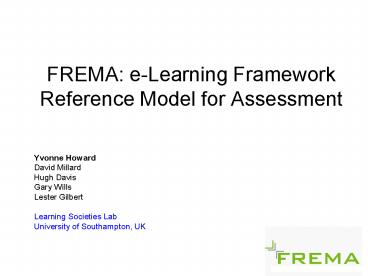FREMA: e-Learning Framework Reference Model for Assessment - PowerPoint PPT Presentation
1 / 16
Title:
FREMA: e-Learning Framework Reference Model for Assessment
Description:
FREMA: e-Learning Framework Reference Model for Assessment. Yvonne Howard. David Millard ... JISC funded Project between Southampton, Strathclyde and Hull ... – PowerPoint PPT presentation
Number of Views:24
Avg rating:3.0/5.0
Title: FREMA: e-Learning Framework Reference Model for Assessment
1
FREMA e-Learning Framework Reference Model for
Assessment
- Yvonne Howard
- David Millard
- Hugh Davis
- Gary Wills
- Lester Gilbert
- Learning Societies Lab
- University of Southampton, UK
2
Background
- What is FREMA?
- JISC funded Project between Southampton,
Strathclyde and Hull - Aim to produce a Reference Model of the
e-Learning Assessment Domain - To aid interoperability and aid in the creation
of Assessment Services for the e-Framework - What is a Reference Model for Assessment?
- Assessment is a broad and complex domain
- Not enough to describe and define a set of
services - Need a proper audit trail of decision making
- Start by defining the domain
- Work up through use cases to services (and
example implementations) - An evolving model
- Allow the Community to contribute to every stage
3
Anatomy of FREMA Reference Model
- Domain Definition
- Overview of the domain, and how projects and
standards fit within it
- Identifying Common Usage Patterns
- Scoping the FREMA Project
- Developing Use Cases
- Formal descriptions of usage patterns
- Gap Analysis
- Mapping of Use Cases to the Services in ELF
Reference Impl
- Service Profiles
- Formal descriptions of those services
Service Profiles
- Example Implementation
- Of key/core services
- Examples
- Validation
- Resource
Assessment Domain Definition
4
Semantic Wiki
- Used to build a semantic wiki (a wiki in which
all the pages and links are typed) - Can model all the levels of the Reference Model
- Enables Smart Searching and Analysis
- Semantic Search
- Dynamic Gap Analysis
- Concept maps
- Open editing, but with Administrator controls
5
(No Transcript)
6
(No Transcript)
7
(No Transcript)
8
(No Transcript)
9
Analysis Tools Gap Analysis
10
Service Usage Model
- Describes a scenario in which services work
together - Use Case Diagram
- Set of Abstract Logical Service Expressions
- Interaction Diagram
11
SUM Description
- Formal as a Use Case Diagram
- Informal as a Narrative Description
12
SUM Structure and Organisation
13
Service Expression
- Logical, abstract description
14
SUM Functionality
- Workflow and processes
- Semi-formalised as a UML Interaction Diagram
15
Scenario Technical Developer
- Will, Technical Developer
- I want to lookup use cases and scenarios to
help me design my application. This will help me
to define my footprint in the assessment domain.
I see there are some web services I could re-use
but some are missing. What standards can I use
when writing my own web services to ensure that I
can interoperate with the web services Ive
chosen?
16
Key Outcomes
- The Community Reference Model itself
- A sustainable community resource
- An agile approach to service design and
specification - Service Usage Models and Service Expressions
- Summative End-to-end
- Peer Review



















![Top 5 Machine Learning Frameworks[2020] PowerPoint PPT Presentation](https://s3.amazonaws.com/images.powershow.com/9437255.th0.jpg?_=20200508073)











